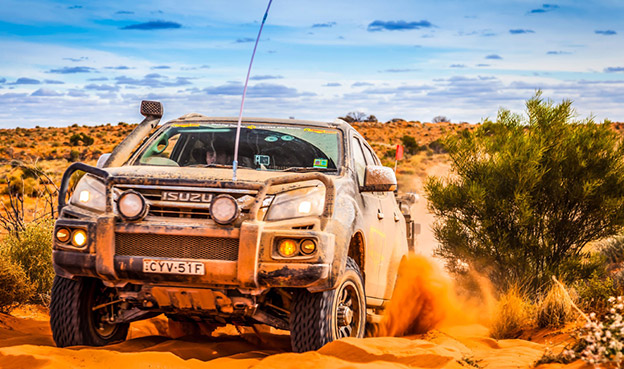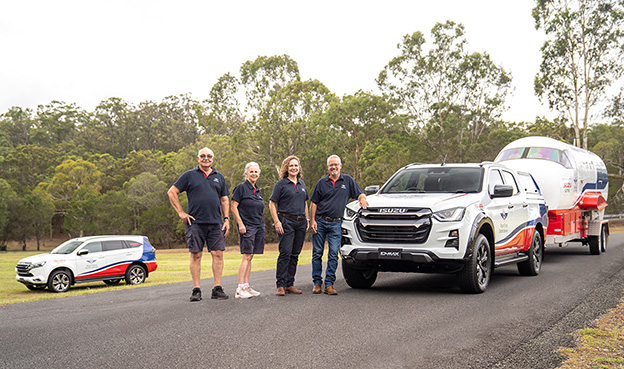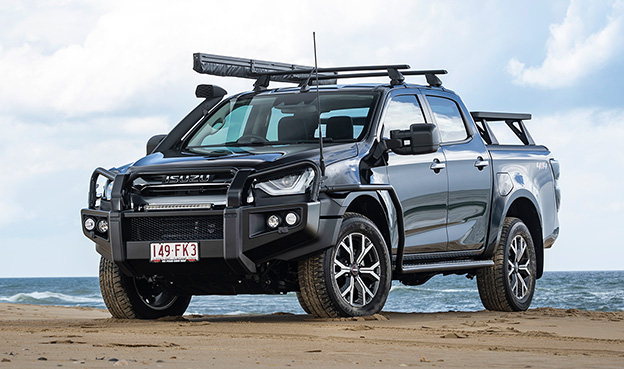

NOTHING SAYS FOUR-WHEEL DRIVING LIKE A DAY OUT ON THE BEACH —BLUE SKIES, BLUER WATER AND ENDLESS EMPTY DUNES.
Sand driving can be the most rewarding type of four-wheel driving you'll ever do, but it can also bite back hard if you're not prepared. More than one off-roader has lost their pride and joy—and their pride—to an incoming tide after getting bogged!
Here's a handful of proven driving tips to ensure sure your dream day at the beach doesn't turn into a sand-filled nightmare.
First up: tyre pressures. As a general rule, go straight down to 16psi—don't mess around. This will increase the overall size of your tyre's footprint that makes contact with the sand, meaning your 4x4 D‑MAX or MU‑X will float across the surface rather than bog down. Think of a tank's footprint or a tractor with large tyres — it's the length of the tread touching terra firma that allows it to walk over the soft ground.
Sand driving is all about momentum - so, no matter what, you’re going to want to keep your vehicle moving. But that doesn’t mean you want to go thundering up every dune you see (as tempting as that might be). It’s all about finding that sweet spot of throttle input that gives you the perfect balance between maintaining momentum and spinning your tyres excessively.
THIS WILL INCREASE THE OVERALL SIZE OF YOUR TYRE'S FOOTPRINT THAT MAKES CONTACT WITH THE SAND, MEANING YOUR 4X4 D‑MAX OR MU‑X WILL FLOAT ACROSS THE SURFACE RATHER THAN BOG DOWN. THINK OF A TANK'S FOOTPRINT OR A TRACTOR WITH LARGE TYRES — IT'S THE LENGTH OF THE TREAD TOUCHING TERRA FIRMA THAT ALLOWS IT TO WALK OVER THE SOFT GROUND.


If you keep one cardinal rule in mind, make it this one: no sudden movements. This means going easy on the throttle and the brakes, and even easier on the steering. Always try to coast to a stop rather than hitting the anchors, which will only cause you to get bogged.
Wherever possible, stop your 4WD so it's facing downwards on a slope. This will help immensely when you go to take off—you'll have gravity on your side. And turn down the slope rather than up it.
A common scenario is this: As your tyres begin to dig in, you start to lose forward momentum. As soon as you feel this happening, take your foot off the accelerator. Most people mistakenly try to accelerate, which only spins the wheels and digs you in further. If you catch this situation early enough, reverse back along your tyre tracks, which are firmer, packed sand, and then have another run at it.

Drive to the tides. Low tide is best, as you'll have the maximum amount of hard-packed sand. Aim to get onto the beach a couple of hours before low tide, and to come back off again no more than a couple of hours after high tide. It pays to consult a tide chart before you leave home.
All beaches are different. Some will be wide and flat, others steep and almost impossible. If in doubt, get some local advice about the beach from others. And always, always, keep a snatch strap handy—if it's not for you, it will be to rescue another four-wheel driver. There's no more promising start to a beautiful friendship than helping out a stranger who's up to his or her axles in silica!
Remember these tips and you'll master beach driving in no time at all.





